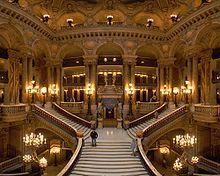- Napoleon III style
-
The Napoleon III style is the name commonly given to a style of architecture in France, especially in Paris, that flourished during the Second French Empire with the patronage of Napoleon III. It is a variant of the Second Empire style used elsewhere throughout the world at the time.
The term "Napoleon III style" (French: style Napoléon III) may be contemporary: legend has it that the when the Empress Eugénie asked architect Charles Garnier whether the Palais Garnier, under construction in 1862, would be built in the Greek or Roman style, he replied, "It is in the Napoleon III style, Madame!"
The Napoleon III style is associated with the renovation of Paris under Baron Haussmann between 1852 and 1870. The buildings of the renovation show a singularity of purpose and design, a consistency of urban planning that was unusual for the period. Numerous public edifices: railway stations, the tribunal de commerce, and the Palais Garnier were constructed in the style. The style is characterised by high façades, mansard roofs, and, more rarely, pavilions. Richly decorated but with clearly defined outlines, Napoleon III structures are somewhat distinct from other Second Empire buildings.
The term is also not reserved exclusively for architecture. It is used also to describe furniture of the period, especially in the marketplace, where other "royal period" styles are commonplace.
References
- "Second Empire style" (2008). In Encyclopædia Britannica. Retrieved 1 June 2008, from Encyclopædia Britannica Online: http://www.britannica.com/eb/article-9066516
Revival styles in Western architecture and decorative arts International Baroque Revival · Beaux-Arts · Neo-Byzantine · Carpenter Gothic · Châteauesque · Egyptian Revival · Gothic Revival · Greek Revival / Neo-Grec · Moorish Revival · Neoclassical · Renaissance Revival / Italianate · Romanesque Revival · Second EmpireBritish Empire Bristol Byzantine · Edwardian Baroque · Indo-Saracenic Revival · Jacobethan · Queen Anne Style · Scots Baronial Style · Tudor RevivalFrance Napoleon III StyleGermany Greece Portugal Russian Empire and USSR Scandinavia Spain United States Jeffersonian architecture · American Renaissance · Colonial Revival · Mayan Revival · Mediterranean Revival · Mission Revival · Pueblo Revival · Queen Anne Style · Richardsonian Romanesque · Spanish Colonial Revival · Territorial RevivalCategories:- French Renaissance Revival architecture
- Second Empire architecture
- Architectural styles
- Revival architectural styles
- French architecture
- French architecture by period
Wikimedia Foundation. 2010.

